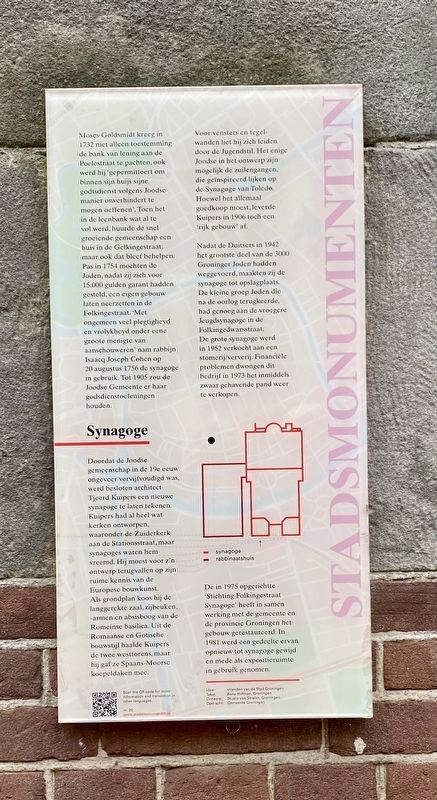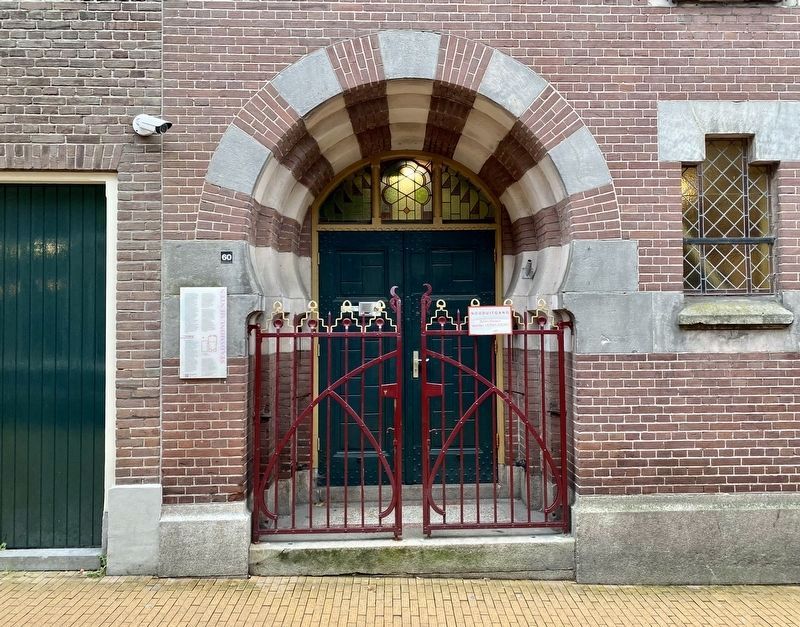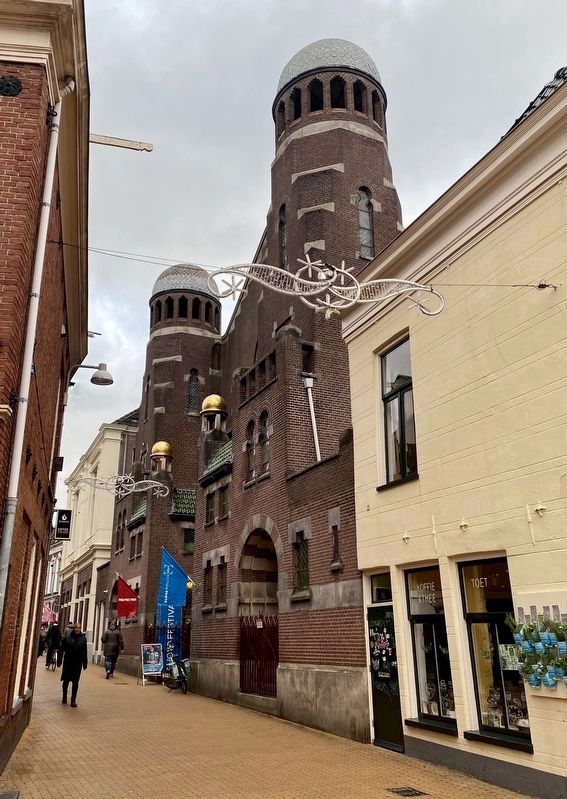Groningen, Netherlands — Northwestern Europe
Synagogue
— Stadsmonumenten —
Doordat de Joodse gemeenschap in de 19e eeuw ongeveer vervijfvoudigd was, werd besloten architect Tjeerd Kuipers een nieuwe synagoge te laten tekenen. Kuipers had al heel wat kerken ontworpen, waaronder de Zuiderkerk aan de Stationsstraat, maar synagoges waren hem vreemd. Hij moest voor z’n ontwerp terugvallen op zijn ruime kennis van de Europese bouwkunst. Als grondplan koos hij de langgerekte zaal, zijbeuken, zijarmen en absisboog van de Romeinse basilica. Uit de Romaanse en Gotische bouwstijl haalde Kuipers de twee westtorens, maar hij gaf ze Spaans-Moorse koepeldaken mee.
Voor vensters en tegelwanden liet hij zich leiden door de Jugendstil. Het enige Joodse in het ontwerp zijn mogelijk de zuilengangen, die geïnspireerd lijken op de Synagoge van Toledo. Hoewel het allemaal goedkoop moest, leverde Kuipers in 1906 toch een ‘rijk gebouw’ af.
Nadat de Duitsers in 1942 het grootste deel van de 3000 Groninger Joden hadden weggevoerd, maakten zij de synagoge tot opslagplaats. De kleine groep Joden die na de oorlog terugkeerde, had genoeg aan de vroegere Jeugdsynagoge in de Folkingedwarsstraat. De grote synagoge werd in 1952 verkocht aan een stomerij/ververij. Financiële problemen dwongen dit bedrijf in 1973 het inmiddels zwaargehavende pand weer te verkopen.
De in 1975 opgerichtte ‘Stichting Folkingestraat Synagoge’ heeft in samenwerking met de gemeente en de provincie Groningen het gebouw gerestaureerd. In 1981 werd een gedeelte ervan opnieuw tot synagoge gewijd en mede als expositieruimte in gebruik genomes.
In 1732, Moses Goldsmidt received not only the consent to lease the bank at the Poelestraat, but he was also allowed to practice his religion according the Jewish manners within his own house. Because of the rapidly growing community, they rented a house at the Gelkingestraat, but this was still not enough. Only in 1754 the Jews were allowed to have their own building at the Folkingestraat after showing an underwriting of ƒ 15,000. With an uncommon solemnity and mirth among a great multitude of eyewitnesses, Rabbi Isaac Joseph Cohen started to practice in the synagogue on the 20th of August, 1756. Until 1905, the Jewish community would hold their services in the synagogue.
Because of the fact, that the Jewish community was 5 times bigger in the 19th century, it was then decided to let architect Tjeerd Kuipers design a new synagogue. Kuipers had already designed many churches including the Zuiderkerk at the Stationstraat, but synagogues were not his area of expertise. For the design of the synagogue he had to rely on his extensive knowledge on European architecture. As part of his main plan he chose for the elongated hall aisles, side arms and the absis-arches of the Roman Basilica. Kuipers made use of two western towers out of the Gothic and Roman architecture but gave them a Spanish Moorish dome roofs. For the windows and tiled walls, he was guided by the Jugendstil. The only possible Jewish component in the design can be found in the archways, which seem to be inspired on the synagogue of Toledo. Despite of the fact that it had to be a low-cost project, Kuipers presented a ‘rich building’ in 1906.
In 1942 the synagogue was used as a storage place after the Germans took away the 3000 Jews of Groningen. The small group of Jews that returned after the war, was already sufficed with former Youth Synagogue at the Folkingedwarsstraat. The great synagogue was sold in 1952 to a dry cleaning/dyeing company. Financial difficulties forced the company to sell the synagogue again in 1973.
The Folkingestraat Synagogue Foundation - which was established in 1975 - restored the building together with the municipality of Groningen. In 1981, a portion of the building was dedicated again as a synagogue and as an exhibition space.
Erected by Gemeente Groningen. (Marker Number 20.)
Topics and series. This historical marker is listed in this topic list: Churches & Religion. In addition, it is included in the Groningen Stadsmonumenten series list. A significant historical date for this entry is August 20, 1756.
Location. 53° 12.89′ N, 6° 33.92′ E. Marker is in Groningen. Marker is at the intersection of Folkingestraat and Gedempte Zuiderdiep, on the right when traveling north on Folkingestraat. Touch for map. Marker is at or near this postal address: Folkingestraat 60, Groningen 9711 JZ, Netherlands. Touch for directions.
Other nearby markers. At least 8 other markers are within walking distance of this marker. Ged. Zuiderdiep 96-98 (within shouting distance of this marker); De Toekomst / “The Future” (about 150 meters away, measured in a direct line); Sociaal Democratische Bond / Social Democratic Union (about 210 meters away); Vismarkt 56 (about 210 meters away); Vereeniging van Groningen Handelaren / Groningen Merchants Association (1847 - 1992) (about 210 meters away); Oprichting van de Loge / Establishment of I.O.O.F. Lodge (about 210 meters away); Korenbeurs / Grain Exchange (approx. 0.2 kilometers away); Vismarkt 40 (approx. 0.2 kilometers away). Touch for a list and map of all markers in Groningen.
Credits. This page was last revised on December 31, 2023. It was originally submitted on November 22, 2022, by Andrew Ruppenstein of Lamorinda, California. This page has been viewed 58 times since then and 5 times this year. Photos: 1, 2, 3. submitted on November 22, 2022, by Andrew Ruppenstein of Lamorinda, California.


